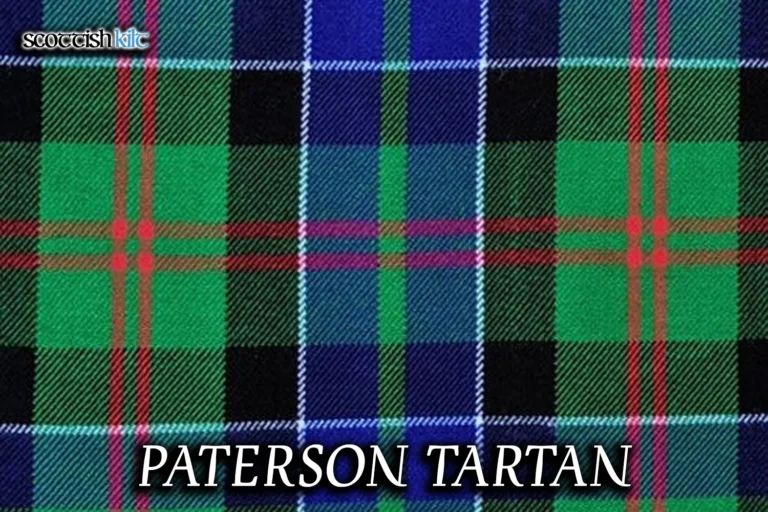The Paterson tartan, a distinctive pattern associated with one of Scotland’s prominent clans, embodies a rich blend of tradition, heritage, and cultural significance. As a symbol deeply rooted in Scottish history, this tartan not only reflects the legacy of the Paterson clan but also plays a vital role in contemporary fashion and cultural expressions. With its unique blend of colors and patterns, the Paterson tartan stands out as a timeless emblem that bridges the past and present. In this article, we explore the fascinating history of the Paterson tartan, its various applications in modern fashion, and its enduring connection to Scottish heritage, offering a comprehensive look at why this tartan continues to captivate and inspire.
The Origins of the Paterson Clan
The Paterson name is a quintessential example of how family names evolve over centuries, often reflecting the linguistic and cultural changes of the time. The origins of the Paterson clan can be traced back to ancient Scotland, where the name is believed to have originated from the Gaelic “MacPhadraig,” which translates to “Son of Patrick.” The name Patrick itself is derived from the Latin name Patricius, meaning “nobleman” or “patrician,” which was widely adopted in the Christian world due to the veneration of Saint Patrick, the patron saint of Ireland. The Paterson clan’s history is intertwined with the broader historical narrative of Scotland. During the medieval period, Scotland was a patchwork of clans, each with its own distinct identity, territory, and leadership. The Patersons were primarily associated with regions in both the Highlands and Lowlands, including areas such as Stirling, Fife, and Perthshire. The clan’s presence in these regions is documented in various historical records, including land charters, legal documents, and parish records.
What is a Tartan? Understanding the Basics
To fully appreciate the significance of the Paterson tartan, it is important to understand what a tartan is and what it represents. Tartans are often considered the quintessential symbol of Scottish heritage, instantly recognizable by their distinctive patterns of intersecting horizontal and vertical stripes in multiple colors. Each tartan is unique, with its design, known as a “sett,” determined by the specific arrangement and combination of colors and stripes. The origins of tartan date back to ancient times, with evidence of tartan-like fabrics being found in archaeological sites across Europe, including the British Isles. However, tartan as we know it today is most closely associated with the Scottish Highlands, where it became a key element of clan identity. By the 16th century, tartans were being woven and worn by Highland clans as a way to distinguish themselves from other clans. Each clan would have its own tartan pattern, which members would wear with pride to signify their allegiance. Tartans are more than just decorative patterns; they are steeped in symbolism and tradition. The colors and patterns of a tartan often reflect the geography, history, and values of the clan it represents. For example, green might symbolize the lush landscapes of the Highlands, while blue could represent Scotland’s lochs and rivers. The arrangement of stripes, known as the “sett,” is meticulously designed to create a balanced and harmonious pattern that is unique to each clan.
The Existence of Paterson Tartan
One of the most common questions asked by those exploring their Scottish heritage is whether a specific tartan exists for their clan. For the Paterson clan, the answer is a resounding yes. The Paterson tartan is a recognized and established pattern that holds a special place within the tapestry of Scottish clan tartans. However, the journey to its recognition is an interesting one, filled with a blend of history, tradition, and modern interpretation. The existence of a clan tartan is often tied to the history of the clan itself. In the case of the Paterson clan, historical records suggest that the clan did not initially have a specific tartan associated with it during the early periods of tartan usage. Unlike some of the more prominent Highland clans, the Patersons were not originally associated with a single geographic region or a powerful chieftainship that would have necessitated a distinct tartan pattern. The formal recognition of the Paterson tartan came later, as the practice of assigning tartans to clans became more widespread in the 19th century. This period saw a revival of interest in Scottish heritage, largely influenced by the romanticism of Sir Walter Scott and the visit of King George IV to Scotland in 1822, where the king famously wore a kilt. During this time, many tartans were either newly designed or officially registered for clans that did not previously have one, including the Paterson clan.
The Design and Colors of Paterson Tartan
The design and colors of the Paterson tartan are more than just an aesthetic choice; they are a carefully crafted representation of the clan’s heritage and values. Each element of the tartan, from the choice of colors to the arrangement of the stripes, is imbued with meaning and significance, making the Paterson tartan a powerful symbol of the clan’s identity. The Paterson tartan is typically characterized by a striking combination of colors, including shades of blue, green, and red. These colors are not chosen at random; each one carries a specific meaning that reflects the history and geography of the Paterson clan. Blue, for example, is often associated with loyalty and truth, qualities that have long been valued by the Patersons. Green is a nod to the lush landscapes of Scotland, particularly the areas where the Patersons have historically lived. Red, on the other hand, symbolizes courage and strength, traits that have been displayed by members of the clan throughout history. The pattern of the Paterson tartan is also significant. The design follows a traditional Scottish sett, with a series of intersecting stripes arranged in a symmetrical pattern. The width and spacing of the stripes are carefully calibrated to create a balanced and harmonious design. This symmetry is not just a visual feature; it represents the balance and harmony that the Patersons strive for in their lives, both within the family and in their interactions with others.
The Significance of Paterson Tartan in Modern Times
In the modern era, the Paterson tartan continues to hold a significant place in the lives of those who identify with the Paterson clan. While the tartan’s origins are rooted in history, its relevance and appeal have only grown with time. Today, the Paterson tartan is more than just a symbol of heritage; it is a versatile and meaningful way for individuals to express their identity, connect with their roots, and participate in the rich cultural traditions of Scotland. One of the key reasons for the continued significance of the Paterson tartan is its role in family and clan gatherings. Events such as weddings, christenings, and clan reunions often feature the tartan prominently, whether as part of the attire or as a decorative element. For many families, these occasions are an opportunity to celebrate their shared heritage and to pass on traditions to the next generation. The Paterson tartan serves as a tangible link to the past, connecting family members across time and space.
Where to Find and Purchase Paterson Tartan
For those interested in acquiring Paterson tartan, whether for personal use or as a gift, there are a variety of options available. The tartan is widely available through both online retailers and traditional Scottish outfitters, making it accessible to anyone, regardless of their location. One of the best places to start is with a reputable kiltmaker or tartan specialist. These businesses often have a wide range of tartans in stock, including the Paterson tartan, and can provide expert advice on selecting the right fabric, pattern, and garment for your needs. Many kiltmakers also offer custom tailoring services, allowing you to have a kilt or other item made to your exact measurements and specifications.
Wearing Paterson Tartan – Traditional and Modern Uses
The Paterson tartan is a versatile and enduring symbol of Scottish heritage, and it can be worn in a variety of ways to suit both traditional and modern styles. Whether you are attending a formal event, participating in a cultural celebration, or simply looking to incorporate a touch of tartan into your everyday wardrobe, there are many ways to wear and display the Paterson tartan. For those interested in traditional Scottish attire, the kilt is the most iconic way to wear tartan. The kilt, with its pleated design and distinctive pattern, is a garment that has been worn by Scots for centuries and remains a popular choice for formal occasions such as weddings, ceilidhs, and clan gatherings. When wearing a Paterson tartan kilt, it is customary to pair it with a sporran (a small pouch worn at the front), a kilt pin, and a belt. A matching tartan sash or shawl can also be worn over the shoulder, adding an extra layer of elegance and tradition. In addition to kilts, the Paterson tartan can be worn in a variety of other traditional forms, such as waistcoats, jackets, and trousers.
Your Destination for Paterson Tartan
When searching for authentic Paterson tartan garments and accessories, a Highland store is your go-to destination. These specialized retailers offer a wide selection of traditional and modern tartan items, from kilts and jackets to scarves and home decor. A Highland store ensures that each piece adheres to the highest standards of quality and craftsmanship, reflecting the rich heritage of Scottish tartan patterns. Whether you’re looking to celebrate your clan heritage or incorporate a touch of Scottish tradition into your wardrobe, visiting a Highland store provides access to genuine Paterson tartan products that honor the timeless appeal of this iconic pattern.
Paterson Tartan and Clan Heritage
The Paterson tartan is more than just a pattern; it is a vital part of the heritage and identity of the Paterson clan. The tartan represents the history, values, and traditions of the clan, serving as a tangible link to the past and a symbol of ongoing legacy. Understanding the connection between the Paterson tartan and clan heritage provides deeper insight into its significance and the role it plays in preserving Scottish culture. The Paterson clan has a rich history that dates back centuries. Originally from the Scottish Borders, the Patersons were known for their involvement in various historical events and their contributions to Scottish society. The tartan design reflects this heritage, incorporating elements that symbolize the clan’s values and historical experiences. By wearing the Paterson tartan, clan members and descendants honor their ancestors and acknowledge the clan’s historical significance. Clan traditions play a crucial role in maintaining the cultural heritage of the Patersons.
The Future of Paterson Tartan
As we look towards the future, the Paterson tartan continues to evolve while maintaining its traditional significance. The tartan’s ability to adapt to changing times while preserving its core heritage is a testament to its enduring appeal and relevance. Exploring the future of the Paterson tartan involves considering its role in modern society, its impact on cultural preservation, and the potential for innovation and adaptation. In recent years, there has been a growing trend towards modern adaptations of traditional tartan patterns. Designers and fashion brands are incorporating tartan into contemporary clothing and accessories, giving the Paterson tartan a fresh and updated look. These modern adaptations include incorporating tartan into casual wear, sportswear, and even high-fashion collections. By embracing these innovations, the Paterson tartan can reach new audiences and remain relevant in today’s fashion landscape.
Conclusion
The Paterson tartan represents more than just a pattern; it embodies a rich heritage, a connection to Scottish traditions, and a symbol of clan identity. From its historical roots to its modern adaptations, the Paterson tartan continues to captivate and inspire individuals around the world. Understanding its significance and exploring its various applications allows us to appreciate its enduring value and relevance in contemporary fashion and culture.

